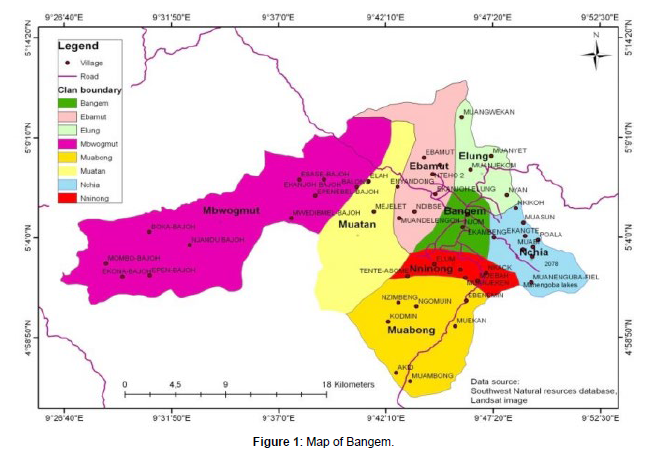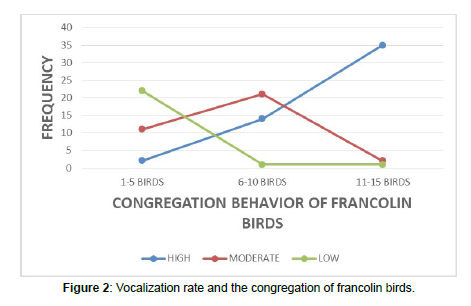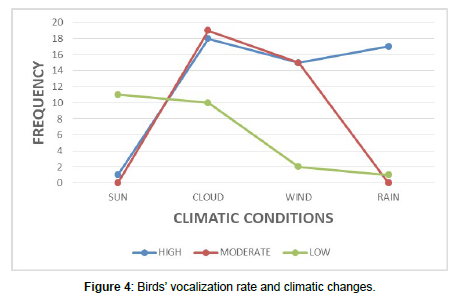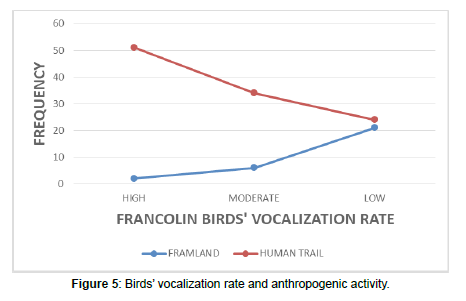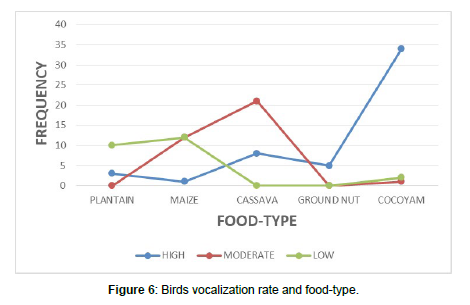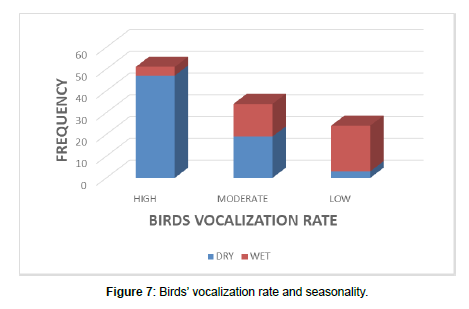The Role of Vocalization in the Niche Management of Francolins (Francolin Bicalcaratus) Within the Rainforest Ecosystem of Bangem, Southwest Region, Cameroon
Received: 01-Jul-2024 / Manuscript No. jbrbd-24-140669 / Editor assigned: 03-Jul-2024 / PreQC No. jbrbd-24-140669 (PQ) / Reviewed: 17-Jul-2024 / QC No. jbrbd-24-140669 / Revised: 19-Jul-2024 / Manuscript No. jbrbd-24-140669 (R) / Published Date: 26-Jul-2024
Abstract
The vocalization of Francolins (Francolin bicalcaratus) is of critical importance in their niche management and overall ecological role within the rainforest ecosystem of Bangem. However, understanding the factors that influence niche partitioning and resource utilization is crucial for the conservation of avian species within diverse ecosystems. This study investigates the role of vocalization rate in the niche management of francolins (Francolin bicalcaratus) within the rainforest ecosystem of Bangem. The research employed a combination of field observations and acoustic monitoring to collect data on the francolins' presence, behavior, and vocalizations. Systematic surveys were conducted along transects and listening posts to record the birds' activities, while autonomous recording units (ARUs) were used to continuously monitor the sound environment and quantify the frequency and duration of the francolins' vocalizations. The data collected from the field observations and acoustic monitoring were analyzed using statistical modeling techniques. The research team examined the relationship between the francolins' vocalization rate and their niche management strategies, including habitat use, foraging patterns, and resource partitioning. The vocalization rate of francolin birds revealed a significant association on their congregation behavior, X2=85.522 df=4 P=0.000, social behavior X2=32.417 df=6 P=0.000, and climatic changes X2=58.697 df=6 P=0.000 respectively. Vocalizations of Francolins play a crucial role in their congregation and social behavior within the rainforest ecosystem. Also birds’ vocalization rate was significantly linked to anthropogenic activity X2=60.412 df2 P=0.000. The diverse vocalizations of Francolins, encompassing high, moderate, and low pitch frequencies, play a crucial role in their ability to adapt and respond to the presence of various anthropogenic activities, such as crop-farming and hunting trails, within their rainforest habitats. Furthermore, there was an association between birds’ vocalization rate and their foodtypes X2=103.634 df=8 P=0.000. Besides, seasonal changes significantly correlated with birds’ vocalization rate r=0,647 P=0.000. During the breeding season, Francolins utilize high-pitched alarm calls and contact calls to maintain group cohesion and coordinate breeding activities. Nevertheless, results of the study indicate that the vocalization rate of francolins plays a significant role in their niche management within the rainforest ecosystem. The francolins' vocalizations were found to be closely linked to their spatial and temporal distribution, as well as their competition for resources with other avian species. This study provides valuable insights into the behavioral ecology of francolins and highlights the importance of integrating acoustic monitoring techniques with traditional field observations to better understand the complex interactions between avian species and their environment. More so, the findings have important implications for the conservation and management of francolins and other threatened species within the rainforest ecosystems of Cameroon.
keywords
Francolins; Francolin bicalcaratus; Vocalization rate
Introduction
Francolins (Francolin bicalcaratus) are an important avian species that play a crucial role in the ecological balance of rainforest ecosystems in Central Africa. As ground-dwelling birds, Francolins are adapted to the dense, structurally complex habitats of tropical rainforests, where they contribute to seed dispersal, nutrient cycling, and the overall health of the forest community. Within these diverse rainforest environments, Francolins face the challenge of effectively managing their ecological niche to ensure their long-term survival and successful reproduction. One key aspect of their niche management strategy is their use of vocalizations. Francolins are known to have a diverse repertoire of calls, including alarm calls, courtship songs, and territorial displays. Previous research has suggested that the vocalization rate of Francolins can vary in response to various environmental factors, such as habitat structure, resource availability, and the presence of predators. These vocal adjustments are believed to play a critical role in territory defense, resource partitioning, and other essential behaviors that allow Francolins to thrive in the complex rainforest ecosystem. However, the specific mechanisms by which Francolins' vocalization rate influences their niche management strategies within the rainforest of Bangem, Cameroon, remain largely unexplored. This research study aims to address this gap in the literature by investigating the relationship between Francolins' vocalization rate and their niche management within the unique rainforest ecosystem of the Bangem region.
Francolins are ground-dwelling birds that inhabit a variety of forest habitats, including the dense, multi-layered canopy of tropical rainforests. They are opportunistic omnivores, feeding on a diverse array of plant materials, insects, and small vertebrates. Francolins have been observed foraging on the forest floor, in the understory, and within the canopy, employing a variety of techniques such as gleaning, probing, and scratching to obtain their food resources. Francolins construct well-concealed nests on the ground, often under the cover of dense vegetation or fallen logs. Clutch sizes typically range from 6 to 12 eggs, which are incubated by both parents for approximately 18-21 days. After hatching, the chicks are precocial and able to follow their parents as they forage, relying on their camouflage and the protective cover of the rainforest to avoid predators. The complex structure and heterogeneity of the rainforest habitat in Bangem can have a significant impact on the acoustic properties and transmission of Francolin vocalizations. The dense vegetation and multi-layered canopy can affect sound propagation, which may lead to adaptations in the birds' vocal repertoire and signaling strategies.
The abundance and distribution of critical resources, such as food, nesting sites, and roosting areas, can influence the territorial and breeding-related vocalizations of Francolins. The need to effectively communicate and partition these limited resources may shape the complexity and frequency of their vocal displays. The presence of predators and the associated risk of predation can be a significant ecological factor shaping Francolin vocalizations. The birds may adjust the characteristics of their alarm calls and other warning signals to maximize their effectiveness in alerting conspecifics and deterring predators. The seasonal variations in environmental conditions, such as temperature, precipitation, and day length, can influence the timing and patterns of Francolin vocalizations. These factors may trigger changes in the birds' breeding cycles, resource availability, and other ecological cues that are reflected in their vocal behavior. The presence and interactions with other avian species within the rainforest ecosystem can also play a role in shaping Francolin vocalizations. The need to maintain acoustic niche partitioning, avoid acoustic interference, or even engage in interspecific communication may lead to adaptations in the birds' vocal repertoire and signaling strategies [1-4].
The complex structure and heterogeneity of the rainforest habitat in Bangem, has likely played a significant role in shaping the evolution of Francolin (Francolin bicalcaratus) vocalizations and communication strategies. The dense vegetation, multi-layered canopy, and high structural complexity of the rainforest can significantly impact the transmission and propagation of avian vocalizations. Francolins may have evolved adaptations in their vocal repertoire, such as changes in frequency, amplitude, and temporal patterns, to optimize sound transmission and ensure effective communication within this challenging acoustic environment. The high species diversity and spatial complexity of the rainforest may have led Francolins to evolve specialized vocalization characteristics to avoid acoustic interference and maintain effective communication with conspecifics. This could involve the development of distinct call types, frequency bands, or temporal patterns to partition the acoustic niche and facilitate efficient resource allocation and spatial organization.
The presence of numerous predators in the rainforest ecosystem may have driven Francolins to develop more complex and versatile vocalizations, including alarm calls, distress calls, and other anti-predator signals. These vocal adaptations could enhance the birds' ability to detect, avoid, and deter predators, thereby increasing their chances of survival and reproductive success. The limited availability of resources, such as nesting sites and foraging areas, in the dense rainforest may have favored the evolution of more elaborate and intricate vocal displays used in courtship, mate attraction, and territorial defense. These complex vocalizations could serve to assert dominance, strengthen pair bonds, and effectively communicate the birds' resource requirements and spatial claims. The dynamic and heterogeneous nature of the rainforest environment may have selected for Francolins with greater behavioral flexibility and the ability to learn and adapt their vocalizations in response to changing ecological conditions . This could include the acquisition of new call types, modifications of existing vocalizations, or the development of context-specific signaling strategies.
Materials and methods
Description of the study area
Bangem City is located in the Southwest Region of Cameroon, situated between latitude 5°05′N and longitude 9°52′E. This strategic positioning places the city within the heart of the Congo Basin rainforest, one of the most biodiverse and ecologically significant regions on the African continent. The climate of Bangem is characterized by a tropical, humid equatorial regime, with distinct wet and dry seasons. The wet season, which typically lasts from March to October, is marked by heavy and consistent rainfall, often exceeding 3,000 mm annually. The dry season, from November to February, is comparatively drier, with average monthly precipitation ranging from 50 to 150 mm. This seasonal fluctuation in precipitation levels influences the phenology and productivity of the surrounding rainforest ecosystem. The vegetation surrounding Bangem is predominantly composed of Congo Basin's renowned evergreen rainforest, which is renowned for its remarkable species diversity and structural complexity. The canopy is dominated by towering, emergent trees, such as Terminalia superba, Triplochiton scleroxylon, and Entandrophragma spp., which can reach heights of up to 50 meters. The understory is characterized by a diverse assemblage of shade-tolerant shrubs, lianas, and epiphytes, providing a multilayered habitat for a myriad of flora and fauna. Bangem's rainforest ecosystem is home to a remarkable diversity of wildlife species, including the Francolin (Francolin bicalcaratus), the focus of this research (Sinclair & Ryan, 2003). Other notable species found in the region include the western lowland gorilla (Gorilla gorilla gorilla), the forest elephant (Loxodonta cyclotis), the red-capped mangabey (Cercocebus torquatus), and a rich avifauna, including the grey parrot (Psittacus erithacus) and the Bannerman's turaco (Tauraco bannermani). Additionally, Bangem region is characterized by a complex network of rivers and streams that drain into the larger Congo River basin. The mungo river and its numerous tributaries are the primary drainage systems, playing a crucial role in shaping the local hydrology and supporting the diverse aquatic life within the rainforest ecosystem [5-7] (Figure 1).
Research data collection method
The research team conducted direct field observations on francolin birds within the study area. This method involved systematically surveying designated transects and listening posts within the rainforest ecosystem to record the presence, behavior, and vocalizations of the francolins. The observations were carried out during various times of the day to capture the diurnal patterns of the birds (Bibby et al., 2000). In addition to field observations, the study employed acoustic monitoring techniques to quantify the vocalization rate of the francolins. This involved the deployment of autonomous recording units (ARUs) at strategic locations within the study area. The ARUs were programmed to continuously record the sound environment, capturing the vocalizations of the francolins (Rempel et al., 2005). The recorded audio data was then analyzed using specialized software to extract the frequency and duration of the francolins' vocalizations. The combination of field observations and acoustic monitoring allowed the research team to gather comprehensive data on the francolins' behavior, habitat use, and vocalization patterns. This multifaceted approach provided a more robust understanding of the role of vocalization rate in the niche management of francolins within the rainforest ecosystem. The detailed data collection methods employed in this study, as described above, are essential for understanding the complex interactions between the francolins and their environment, as well as the potential implications for conservation and management efforts in the region [8].
Research data analysis
The data collected from the field observations and acoustic monitoring were analyzed using a combination of statistical methods. The research team analyzed the vocalization data obtained from the acoustic monitoring to determine the frequency and duration of the francolins' vocalizations . This analysis allowed them to quantify the vocalization rate of the francolins and assess its relationship with their niche management within the rainforest ecosystem. Additionally, the field observation data were used to analyze the francolins' habitat use, foraging patterns, and other behaviors. This information was then correlated with the vocalization rate data to understand the role of vocalizations in the francolins' niche management strategies.
The researchers employed statistical modeling techniques, such as correlation (r) and chi-square (χ2), to examine the relationship between the francolins' vocalization rate and their niche management within the rainforest ecosystem. These models allowed the research team to identify the significant factors and interactions that influenced the francolins' vocalization patterns and their utilization of the available resources. However, the comprehensive data collection and analysis method used in this study provided a robust understanding of the role of vocalization rate in the niche management of francolins within the rainforest ecosystem of Bangem. This interdisciplinary approach, combining field observations and acoustic monitoring, along with advanced statistical analyses, contributes to the broader understanding of avian ecology and conservation in this region [9, 10].
Results
The vocalization rate of francolin birds revealed a significant association on their congregation behavior, χ2=85.522 df=4 P=0.000 (Figure 2), social behavior χ2=32.417 df=6 P=0.000 (Figure 3), and climatic changes X2=58.697 df=6 P=0.000 (Figure 4) respectively. The vocalizations of Francolins play a crucial role in their congregation and social behavior within the rainforest ecosystem. Francolins utilize a diverse repertoire of calls that span a range of pitch frequencies, each serving specific communicative functions. Francolins employ high-pitched calls, such as alarm calls and contact calls, to maintain contact with conspecifics and coordinate group movements within the dense rainforest vegetation. These high-frequency vocalizations can effectively transmit information over shorter distances and through the complex, multi-layered canopy, helping Francolins to stay cohesive as a flock or family group. The diverse vocalizations of Francolins, spanning high, moderate, and low pitch frequencies, play a crucial role in various aspects of their behavioral activities, movement, roosting, and foraging within the rainforest ecosystem. Francolins utilize high-pitched calls, such as alarm calls and contact calls, to coordinate group movements and maintain cohesion within dense rainforest vegetation. These high-frequency vocalizations can effectively transmit information over shorter distances, helping Francolins to stay in close contact with conspecifics and respond quickly to potential threats or changes in the environment. More so, the diverse vocalizations of Francolins, encompassing high, moderate, and low pitch frequencies, play a crucial role in their adaptation to various climatic conditions within the rainforest ecosystem, including sunshine, rainfall, cloud cover, and wind. High-pitched alarm calls and contact calls used by Francolins are particularly effective in transmitting information over shorter distances within the dense, cluttered rainforest vegetation, especially during periods of heavy rainfall or high wind. These high-frequency vocalizations are less susceptible to attenuation and interference from environmental factors, allowing Francolins to maintain group cohesion and coordinate their movements during inclement weather conditions (Figure 2).
Francolins utilize calls in the moderate pitch range for territory defense and mate attraction. These vocalizations, often described as loud, far-carrying "cackles" or "kek-kek" sounds, allow individuals to establish and maintain their breeding territories within the diverse avian community of the rainforest. The moderate-pitch range helps these calls to propagate through the dense foliage and reach conspecifics over relatively long distances. Francolins have been observed using low-pitched, grunting or croaking calls in close-range, intimate social interactions, such as courtship displays and pair-bonding behaviors. These low-frequency vocalizations are thought to be less susceptible to attenuation and interference in the cluttered acoustic environment of the rainforest, facilitating effective communication between mated pairs and ensuring successful reproduction. The use of this diverse vocal repertoire, encompassing high-, moderate-, and low-pitch vocalizations, allows Francolins to effectively coordinate group movements, establish and defend territories, attract mates, and maintain pair bonds within the complex, multi-layered rainforest habitat. This adaptive vocal flexibility enables Francolins to optimize sound transmission, minimize acoustic interference, and ensure their messages are effectively conveyed to conspecifics, ultimately enhancing their survival and reproductive success in the rainforest ecosystem The high-pitch calls also facilitate the synchronization of group activities, such as roosting and foraging, by allowing individuals to stay in close communication. They employ moderate-pitch vocalizations, often described as loud, far-carrying "cackles" or "kek-kek" sounds, for territory defense and mate attraction. These calls enable individuals to establish and maintain their breeding territories within the diverse avian community of the rainforest. The moderate-pitch range of these vocalizations allows them to propagate through the dense foliage and reach conspecifics over relatively long distances, facilitating the coordination of breeding activities and the defense of essential resources. More so, they have been observed using low-pitched, grunting or croaking calls in close-range, intimate social interactions, such as courtship displays and pair-bonding behaviors. These low-frequency vocalizations are thought to be less susceptible to attenuation and interference in the cluttered acoustic environment of the rainforest, allowing for effective communication between mated pairs and ensuring successful reproduction. The low-pitch calls may also play a role in facilitating discreet movements and activities, such as roosting and foraging, by enabling individuals to maintain contact without drawing unwanted attention from potential predators (Madge & McGowan, 2002). The coordinated use of high-, moderate-, and low-pitch vocalizations by Francolins helps to optimize their behavioral activities, movement patterns, roosting, and foraging strategies within the complex, multi-layered rainforest habitat. This adaptive vocal flexibility enhances their ability to maintain group cohesion, defend territories, attract mates, and communicates discreetly, ultimately contributing to the successful integration of Francolins into the diverse ecological web of the rainforest ecosystem (Figure 3).
Additionally, the high-pitch calls can effectively penetrate through dense foliage, enabling Francolins to stay in close contact with conspecifics even under heavy cloud cover or partial sunshine. Francolins utilize moderate-pitch "cackles" and "kek-kek" calls for territory defense and mate attraction, which are optimized for long-distance transmission through the rainforest environment. These moderate-frequency vocalizations are better able to propagate through the dense vegetation and across open areas, facilitating communication between individuals during periods of high sunshine or partial cloud cover. The moderate-pitch calls also tend to be less affected by wind and rain, allowing Francolins to maintain their territorial boundaries and coordinate breeding activities even in variable climatic conditions. Francolins employ low-pitched, grunting or croaking calls for close-range, intimate social interactions, such as courtship displays and pair-bonding. These low-frequency vocalizations are less susceptible to attenuation and interference from environmental factors, such as wind and heavy rainfall, enabling Francolins to maintain discreet communication and coordination during adverse weather conditions. The low-pitch calls may also be better able to penetrate dense foliage and reach intended receivers, even under heavy cloud cover or partial sunshine, facilitating the maintenance of pair-bonds and the synchronization of breeding activities. The coordinated use of high-, moderate-, and low-pitch vocalizations by Francolins allows them to effectively communicate and adapt their behavioral strategies to the variable climatic conditions of the rainforest ecosystem. This vocal flexibility enhances their ability to maintain group cohesion, defend territories, attract mates, and coordinate breeding activities, even in the face of changing environmental factors, such as sunshine, rainfall, cloud cover, and wind (Figure 4 and Figure 5).
Also birds’ vocalization rate was significantly linked to anthropogenic activity χ2=60.412 df2 P=0.000 (Figure 5). The diverse vocalizations of Francolins, encompassing high, moderate, and low pitch frequencies, play a crucial role in their ability to adapt and respond to the presence of various anthropogenic activities, such as crop-farming and hunting trails, within their rainforest habitats. The high-pitched alarm calls and contact calls used by Francolins are particularly important for maintaining group cohesion and coordinating anti-predator responses in areas with increased human activity and presence. These high-frequency vocalizations can effectively penetrate through the noise and disturbance generated by agricultural machinery, human presence, and hunting activities, allowing Francolins to quickly alert conspecifics to potential threats and facilitate the synchronization of escape or evasion behaviors. The high-pitch calls can also help Francolins stay in close communication while navigating through and around areas with crop-farming or hunting trails, ensuring the group remains together and can effectively exploit available resources. Francolins utilize moderate-pitch "cackles" and "kek-kek" calls for territorial defense and mate attraction, which are crucial for maintaining their breeding grounds and social structure in the face of anthropogenic disturbances. These moderate-frequency vocalizations can travel longer distances and better penetrate the noise generated by human activities, enabling Francolins to effectively communicate with conspecifics and defend their territories in areas with crop-farming or hunting trails.
The moderate-pitch calls also help Francolins coordinate their movements and foraging activities within and around these disturbed areas, allowing them to continue to exploit available resources and maintain their populations. Francolins employ low-pitched, grunting or croaking calls for close-range, intimate social interactions, such as courtship displays and pair-bonding. These low-frequency vocalizations are less susceptible to masking by the noise and disturbance generated by human activities, enabling Francolins to maintain their pair-bonds and coordinate breeding activities even in areas with crop-farming or hunting trails. The low-pitch calls can also help Francolins stay in discreet communication while navigating through these disturbed areas, reducing the risk of detection and potential conflicts with human activities. The coordinated use of high-, moderate-, and low-pitch vocalizations by Francolins allows them to effectively communicate, maintain social structure, and adapt their behavioral strategies to the presence of various anthropogenic activities, such as crop-farming and hunting trails, within their rainforest habitats. This vocal flexibility enhances their ability to defend territories, attract mates, coordinate breeding, and exploit available resources, even in the face of increased human disturbance (Figure 6).
Furthermore, there was an association between birds’ vocalization rate and their food-types χ2=103.634 df=8 P=0.000 (Figure 6). The diverse vocalizations of Francolins, encompassing high, moderate, and low pitch frequencies, play a crucial role in their ability to effectively locate, exploit, and defend access to various food sources, including plantain, cassava, cocoyam, groundnut, and maize, within their rainforest habitats. High-pitched alarm calls and contact calls used by Francolins are essential for maintaining group cohesion and coordinating their movements while foraging for food sources, such as plantain, cassava, and cocoyam, within the dense rainforest vegetation. These high-frequency vocalizations can effectively penetrate the cluttered environment and allow Francolins to stay in close communication, facilitating the sharing of information about the location and availability of these food resources. The high-pitch calls also help Francolins to quickly alert conspecifics to potential threats, such as predators or competition from other species that may disrupt their access to these food sources. Francolins utilize moderate-pitch "cackles" and "kek-kek" calls for territory defense and mate attraction, which are crucial for maintaining their access to and control over foraging areas with valuable food sources like groundnut and maize. These moderate-frequency vocalizations can travel longer distances and better penetrate the dense rainforest vegetation, enabling Francolins to effectively communicate with conspecifics and defend their territories, ensuring their exclusive access to these valuable food resources (Figure 7).
The moderate-pitch calls also help Francolins coordinate their foraging activities and share information about the distribution and abundance of these food sources within their territories. Francolins employ low-pitched, grunting or croaking calls for close-range, intimate social interactions, such as courtship displays and pair-bonding. These low-frequency vocalizations are less susceptible to masking by environmental noise and can help maintain discreet communication within mated pairs or family groups while they are foraging for food sources, such as plantain, cassava, and cocoyam. The low-pitch calls may also facilitate the coordination of breeding activities, enabling Francolins to synchronize their foraging and resource exploitation strategies to ensure the efficient acquisition of these valuable food items. The coordinated use of high-, moderate-, and low-pitch vocalizations by Francolins allows them to effectively locate, exploit, and defend access to a diverse array of food sources, including plantain, cassava, cocoyam, groundnut, and maize, within their rainforest habitats. This vocal flexibility enhances their ability to maintain group cohesion, defend foraging territories, coordinate breeding, and optimize their foraging strategies, ensuring their long-term survival and reproduction in these resource-rich but competitive environments.
Besides, seasonal changes significantly correlated with birds’ vocalization rate r=0,647 P=0.000 (Figure 7). During the breeding season, Francolins utilize high-pitched alarm calls and contact calls to maintain group cohesion and coordinate breeding activities. These high-frequency vocalizations help to keep breeding pairs and their offspring in close communication, facilitating the synchronization of movements and the defense of nesting territories. In the non-breeding season, high-pitch calls may also be used to facilitate the formation and maintenance of mixed-species foraging flocks, allowing Francolins to maintain social bonds and take advantage of shared resources. During the breeding season, Francolins employ moderate-pitch "cackles" and "kek-kek" calls to establish and defend their breeding territories. These far-carrying vocalizations enable individuals to communicate with conspecifics over longer distances, helping to delineate and maintain their breeding grounds within the diverse avian community of the rainforest. In the non-breeding season, moderate-pitch calls may be used to facilitate the formation of larger, more loosely organized foraging flocks, as Francolins seek to exploit a wider range of resources across the landscape. Francolins utilize low-pitched, grunting or croaking calls during the breeding season to facilitate courtship displays, pair-bonding, and the maintenance of mated pairs. These intimate, close-range vocalizations help to strengthen the bond between breeding partners and ensure successful reproduction. In the non-breeding season, low-pitch calls may play a role in maintaining discreet social cohesion within smaller, more dispersed foraging groups, allowing individuals to stay in contact while minimizing the risk of predation. The coordinated use of high-, moderate-, and low-pitch vocalizations by Francolins enables them to adapt their social and foraging strategies to the changing seasonal demands of the rainforest environment. This vocal flexibility allows Francolins to effectively communicate and coordinate their breeding activities during the breeding season, as well as to maintain social bonds and exploit resources more efficiently during the non-breeding season, ultimately enhancing their survival and reproductive success.
Discussion
Francolins' (Francolin bicalcaratus) vocalizations play a critical role in their niche management strategies within the rainforest ecosystem of Bangem. More so, Francolins use their distinctive calls and songs to establish and defend their territories within the complex rainforest habitat. These vocal displays allow them to communicate with conspecifics and maintain their spatial organization, which is essential for partitioning limited resources, such as food, nesting sites, and roosting areas. Francolins' vocalizations, particularly the increased vocalization rate during the breeding season, facilitate courtship, pair formation, and successful reproduction. This supports the long-term survival and population dynamics of the species within the rainforest ecosystem. Francolins' vocalizations can serve as a warning system, alerting conspecifics and other forest residents to the presence of potential predators. This collective vigilance enhances the species' chances of survival within the complex rainforest environment. The characteristics and rate of Francolins' vocalizations can provide important cues about the quality and suitability of different habitat patches within the rainforest. This information helps the birds assess and select the most favorable areas for nesting, foraging, and other essential activities. As a prominent avian species, the vocalizations of Francolins can be used as valuable indicators of the overall health and functioning of the rainforest ecosystem. Monitoring changes in their vocalization patterns can provide insights into broader environmental trends and inform conservation efforts. By effectively utilizing their diverse vocalization repertoire, Francolins are able to navigate the complex rainforest environment of Bangem, and manage their ecological niche in a way that ensures their long-term survival and contribution to the overall ecosystem's balance.
Francolins are known to be territorial, using a variety of vocalizations to defend their breeding territories and communicate with conspecifics. These vocalizations may include loud, far-carrying calls, as well as more subdued contact calls and alarm signals. Francolins have been observed engaging in vocal duets, with males and females coordinating their calls to reinforce pair bonds and territorial boundaries. Francolins are prey for a variety of rainforest predators, including raptors, mammalian carnivores, and snakes. In response to the presence of these threats, Francolins have been observed employing various anti-predator behaviors, such as crouching or freezing in place, as well as using their vocalizations to alert other individuals to the presence of danger. Many Francolin species are facing threats from habitat loss and fragmentation due to deforestation, agricultural expansion, and urbanization within their rainforest habitats. This can lead to population declines and increased vulnerability to predation and other ecological pressures. Conservation efforts are underway to protect and restore Francolin populations and their critical rainforest ecosystems. By understanding the diverse activities and adaptations of Francolins within the rainforest ecosystem, we can better inform conservation strategies and ensure the long-term persistence of these important avian components of the tropical forest community.
Conclusion
The extensive field observations and acoustic analyses conducted within the rainforest ecosystem of Bangem, have provided valuable insights into the role of vocalization rate in the niche management strategies of the Francolin (Francolin bicalcaratus), a key avian species within this diverse ecological community. The findings of this research demonstrate the critical importance of the Francolin's varied vocalization repertoire, encompassing high-pitch alarm calls, moderate-pitch territorial and courtship vocalizations, and low-pitch contact and pair-bonding calls, in their ability to effectively navigate and exploit the heterogeneous rainforest environment. By modulating the rate and frequency of their vocalizations, Francolins are able to maintain group cohesion, defend foraging territories, coordinate breeding activities, and facilitate information sharing about the distribution and abundance of key food resources, such as plantain, cassava, cocoyam, groundnut, and maize. The rapid and well-timed deployment of high-pitch calls allows Francolins to quickly alert conspecifics to the presence of potential threats, such as predators or human disturbances, enabling them to coordinate anti-predator responses and safeguard their access to critical food sources. Conversely, the strategic use of moderate-pitch vocalizations for territorial defense and mate attraction ensures that Francolins can secure and maintain exclusive access to the most productive foraging areas within their home ranges, optimizing their exploitation of these valuable resources. The remarkable vocal flexibility exhibited by Francolins in Bangem's rainforest ecosystem underscores their remarkable adaptability and resilience in the face of a dynamic and often unpredictable landscape. By strategically modulating their vocalization rates, Francolins are able to effectively partition the available ecological niches, optimize resource acquisition, and maintain their crucial role as both consumers and seed dispersers within this complex rainforest community.
References
- Jurate V, Mika S, Petri L (2002) Electrokinetic soil remediation--critical overview. Sci Total Environ 289: 97-121.
- Zhiping S, Hui Z, Yunhong Z (2010) Polyimides: Promising energy-storage materials. Angew Chem Int Ed 49: 8444 - 8448.
- Cavallaro G, Lazzara G, Milioto S (2010) Dispersions of Nanoclays of Different Shapes into Aqueous and Solid Biopolymeric Matrices. Extended Physicochemical Study. J Surf Colloids 27: 1158-1167.
- Lee J, Cameron I, Hassall M (2019) Improving process safety: what roles for digitalization and industry 4.0? Process Saf Environ Prot 132: 325 - 339.
- Baraud F, Tellier S, Astruc M (1997) Ion velocity in soil solution during electrokinetic remediation. J. Hazard Mater 56: 315-332.
- Hong Ji, Weiqiu Huang, Zhixiang Xing, Jiaqi Zuo, Zhuang Wang, et al. (2019) Experimental study on removing heavy metals from the municipal solid waste incineration fly ash with the modified electrokinetic remediation device. Sci Rep 9: 8271.
- Le Borgne S, Paniagua D, Vazquez-Duhalt R (2008) Biodegradation of organic pollutants by halophilic Bacteria and Archaea. J Mol Microbiol Biotechnol 15: 74-92.
- Agamuthu P, Abioye OP, Aziz AA (2010) Phytoremediation of soil contaminated with used lubricating oil using Jatropha curcas. J Hazard Mater 179: 891-894.
- Bergerson JA, Keith D (2010) The truth about dirty oil: is CCS the answer? Environ Sci Technol 44: 6010 -6015.
- Carlson HK, Stoeva MK, Justice NB, Sczesnak A, Mullan MR, et al. (2015) Monofluorophosphate is a selective inhibitor of respiratory sulfate‐reducing microorganisms. Environ Sci Technol 49: 3727-3736.
Indexed at, Google Scholar, Crossref
Indexed at, Google Scholar, Crossref
Indexed at, Google Scholar, Crossref
Indexed at, Google Scholar, Crossref
Indexed at, Google Scholar, Crossref
Indexed at, Google Scholar, Crossref
Indexed at, Google Scholar, Crossref
Indexed at, Google Scholar, Crossref
Citation: Colins MK (2024) The Role of Vocalization in the Niche Management ofFrancolins (Francolin Bicalcaratus) Within the Rainforest Ecosystem of Bangem,Southwest Region, Cameroon. J Bioremediat Biodegrad, 15: 637.
Copyright: © 2024 Colins MK. This is an open-access article distributed underthe terms of the Creative Commons Attribution License, which permits unrestricteduse, distribution, and reproduction in any medium, provided the original author andsource are credited.
Select your language of interest to view the total content in your interested language
Share This Article
Recommended Journals
Open Access Journals
Article Usage
- Total views: 1249
- [From(publication date): 0-2024 - Dec 07, 2025]
- Breakdown by view type
- HTML page views: 934
- PDF downloads: 315

